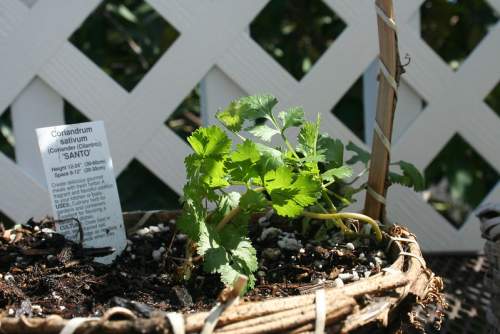Cilantro turning yellow is a huge problem that people suffer when growing these species but don’t feel discouraged and grow Cilantros. Cilantro is used as a flavorsome addition to various varieties of soups, curries, salads, and various other dishes as well. It is also known as coriander.
In the United States, it is commonly and largely known as leaves, and coriander is known as seeds. The nutritional content of this is very much essential and also has various health benefits attached to it.
Benefits of Cilantro
Cilantro provides anticancer effects and also adds flavors to a wide variety of various dishes. It motivates the health of the skin and also has properties to fight various diseases and infections. The use of Cilantro has various other benefits attached to it. So grow Cilantro but in the right way to avoid turning yellow.
Why Cilantro Turning Yellow?

Cilantro can also turn yellow when it is not getting enough sun, water, or nitrogen. Other causes could be overwatering and even pest control spraying. Various other causes associated with Cilantro are
1. Insufficient Light And Heat can Turn Cilantro Yellow
Usually, this species is added to the list of the species of herbs. This is because these herbs don’t need much of the sun. These species don’t even do well in the dark areas also. This means that this can’t grow well in the shade as well. A dim-lit window is also a poor option for this species.
So the correct way to grow them is in full sun, but the temperature must be cool. The correct temperature range must be 50 and 85 degrees Fahrenheit.
Fixing this problem in various simple steps
Try switching the Cilantro’s position once and try to keep it under broad sunshine. Try to increase the lighting if you are trying to grow Cilantro indoor.
Always try to prune the Cilantro to ensure that the leaves are towered in your salad instead of harvesting them.
Also Read: Cauliflower Leaves Turning Yellow
2 Under and overwatering of the Cilantro
When you overwater Cilantro, the leaves are known to turn yellowish in color. If you are really going for container gardening, then this is the common problem observed.
Due to overwatering, the soil gets deprived of oxygen. Thus the overall functionality is inhibited and also leads to chlorosis. Don’t try to determine the present moisture content of the soil by seeing the surface; dig deep to know more.
If you find out that it is wet, then you are overwatering if you keep on adding water to it. This is a bad practice and can affect the plant in the worst manner.
Some signs of overwatering
- Some leaves turn black.
- The Cilantro doesn’t become less wilted after watering.
- Leaves turn yellow and fall.
- You notice mildew on your herbs.
Also Read: Holes In Pepper Plant Leaves
3. Dehydration
When you underwater Cilantro, it leads to chlorosis. If you really want to explore deep soil and also want them soft and in good shape, avoid underwatering them. Only under the full sun water the plants at least one time a week. Then try to observe its various growing conditions and see them grow well. Do see how it reacts to different water quantities and amounts and keep the level in great check as well as adjustment.
4 Yellowing of Cilantro due to nutrient deficiency
For the growth of Cilantro, you need various nutrients. Therefore, you will have to note the particular amount of minerals and fertilizers they require. Don’t try to over fertilize; this could lead to permanent damage to the Cilantro.
The various nutrient deficiencies resulting in the yellowing of the Cilantro are
Nitrogen deficiency
Older kinds of leaves rapidly turn yellow, and the newer shoots also turn in this way due to this deficiency.
Iron Deficiency
Younger leaves are very much yellow in color and with various traces of green veins, while mature leaves are green in color due to this deficiency.
Magnesium Deficiency
The lower kind of leaves become yellowed from both sides, and the veins remain green in color. This happens due to this deficiency in the plant.
Manganese Deficiency
The presence of the yellow spots shows the Manganese Deficiency.
Hence one should look at these things if the plant is turning yellow in color. Fighting with these deficiencies helps to combat these deficiencies and make the plant grow healthy and well.
Also Read: Does Swiss Chard Grow Back After Cutting
5. Pests and various other diseases have the capability of turning Cilantro Yellow
Pests have the capability of causing yellowish patches and have the capability of turning the whole batch yellowish in color. Pests and other diseases can be a culprit and hence turn the Cilantro yellow.
Aphids
Aphids have the capability of turning the leaves yellowish in color. These insects use their mouth organs to suck the sap out of the leaves they popularly come in contact with. This process distorts the leaves and turns them yellowish in color. These creatures are well aware of the ways in which you can easily camouflage well. Therefore, there is a huge possibility of missing them at the first instance or even at first glance.
A sticky substance below the leaves shows the possibility of chlorosis. You may see small insects lingering on the plant parts.
Most people are a believer of the fact that Cilantro repels aphids from them. This is not true. The green color peach aphids attack Cilantro. This can be reduced by following various predatory measures. The common measures include lady beetles, lace wigs, and many more things.
6. Carrot Motley Dwarf Disease
This is a very toxic disease and turns the Cilantro yellow in color, or even orange and even red in color. It is caused by various combinations of different viruses and can be mistaken for nutritional deficiency as well. If you are doing everything correctly, and then also the plant is turning yellow, then the broad chances are the plant suffers from some nutrient kind of deficiency. Ensure the plants are weed-free and possess subsequent nutrition as well.
7. Leaf Spot
If your leaves look like they are soaked in water, but with different yellow spots, then there is something wrong going on. Transmission is possible during pollination. The planted seeds may carry the transmitted diseases. If this is the case, the Cilantro will also look yellow.
To control the further spread of this disease:
- Plant certified type of pathogen-free seeds.
- Sanitize the various pots you’re going to reuse or avoid that altogether.
- Remove the infected plants.
- Sterilize potting type mixes when the seed is starting.
How to turn the leaves green again?
Reversing chlorosis is possible in the case where the following problem is there
- Early lighting and temperature issues
- Light underwatering
- Nutrient deficiency
You are unlikely to turn the Cilantro green again because of the following reasons
- The leaves are old
- Diseases stem from seeds.
- You overwatered repeatedly and caused root rot.
- Pests affected your crop adversely.
Rectifying these issues can help you stop the yellowing of the Cilantro without much effort.
Can you consume the Cilantro that turned yellow in color?
Better Health Channel (BHC) avoids the consumption of Cilantro that has turned yellow,. Eating a yellow, brown, witted Cilantro may cause you any damages. See the cause of the yellowing of the Cilantro first and then decide what to do next.
Suppose by any chance any disease or aphids infected the Cilantro. In that case, it is better to throw them away as the plant may infect you as well and can result in very bad consequences in the long as well as the short run; however, if you figure out that the moisture stress, nutrient deficiency,temperature plus light imbalances have caused the yellowing of the Cilantro, then the Cilantro is very much safe from the disease. Still, it does not mean that you can consume it very quickly.
Can yellow Cilantro be bolted?
As long as you see the Cilantro not at all dying, you can easily bolt it very well. If the Cilantro lacked a portion of sunlight and you are willing to use the batch for the popular seed production. You can efficiently take it to the brighter areas so that you can easily go for bolting it very well.
Do check that there is no presence of any disease; then only you can ensure the growth of healthy Cilantro. So finding a good Cilantro to keep it disease-free is very much essential as well.
Conclusion
Cilantro is very good and has good nutritional values as well. These can be grown very easily without any issues and provides good nutritional values when they are not yellow in color. So avoid them becoming yellow in nature and then grow them without any issues. Growing a Cilantro needs extreme care and caution. People from time immemorial have used Cilantro. Growing them using different but right techniques will help you have healthy products that can be used as a salad or for any other eating purpose. I hope you to have healthy Cilantro and stay away from the yellow ones.
